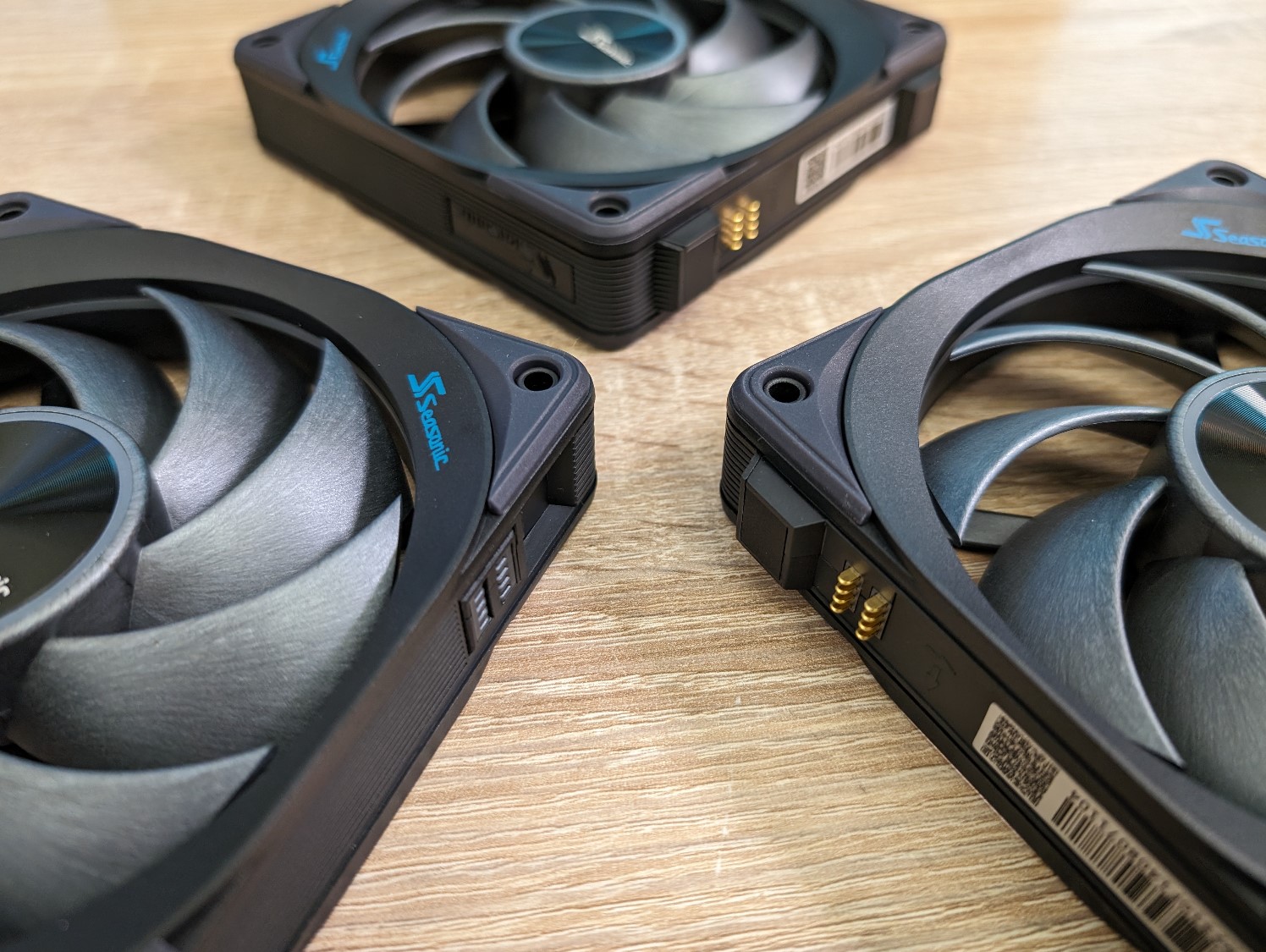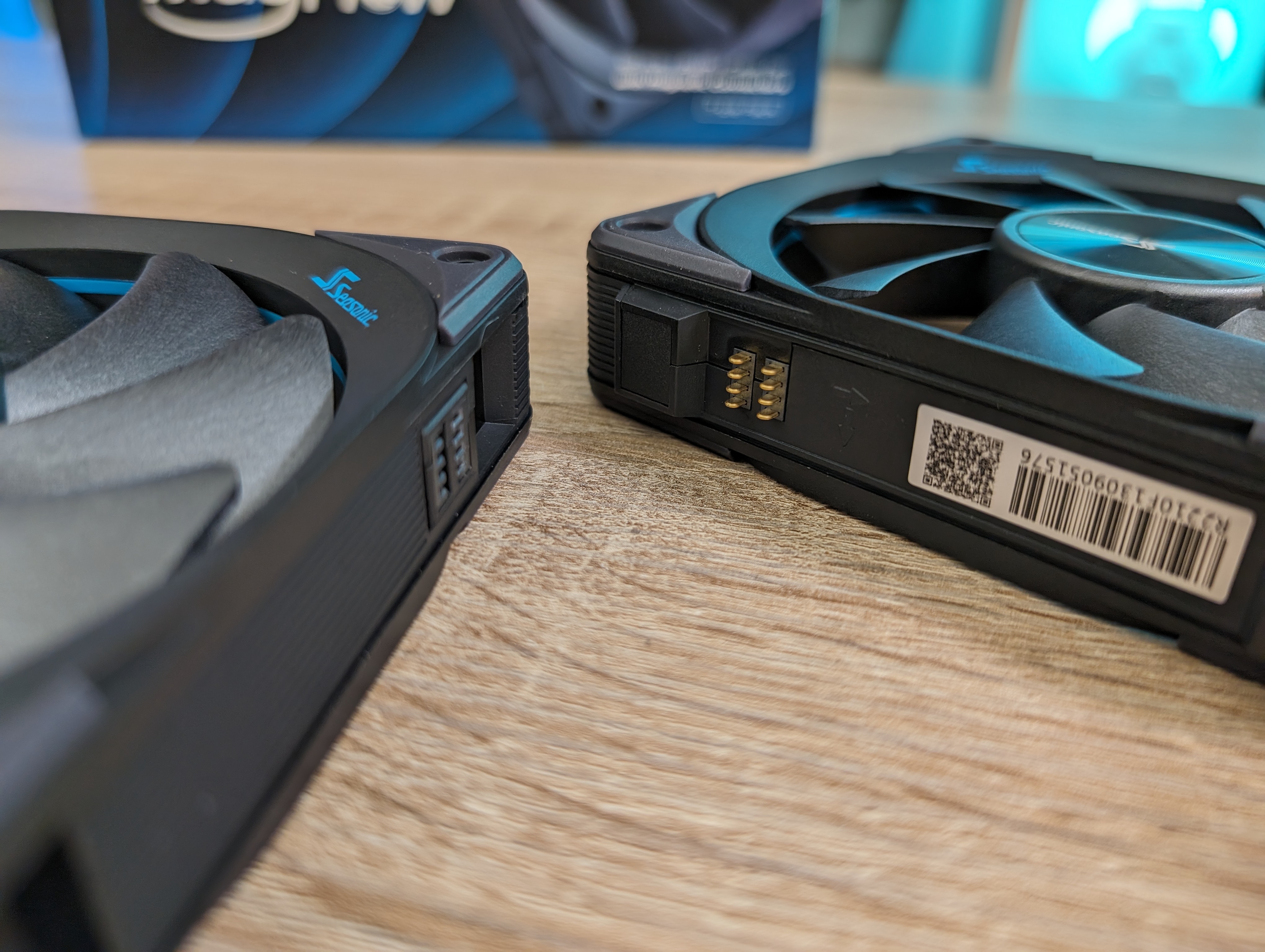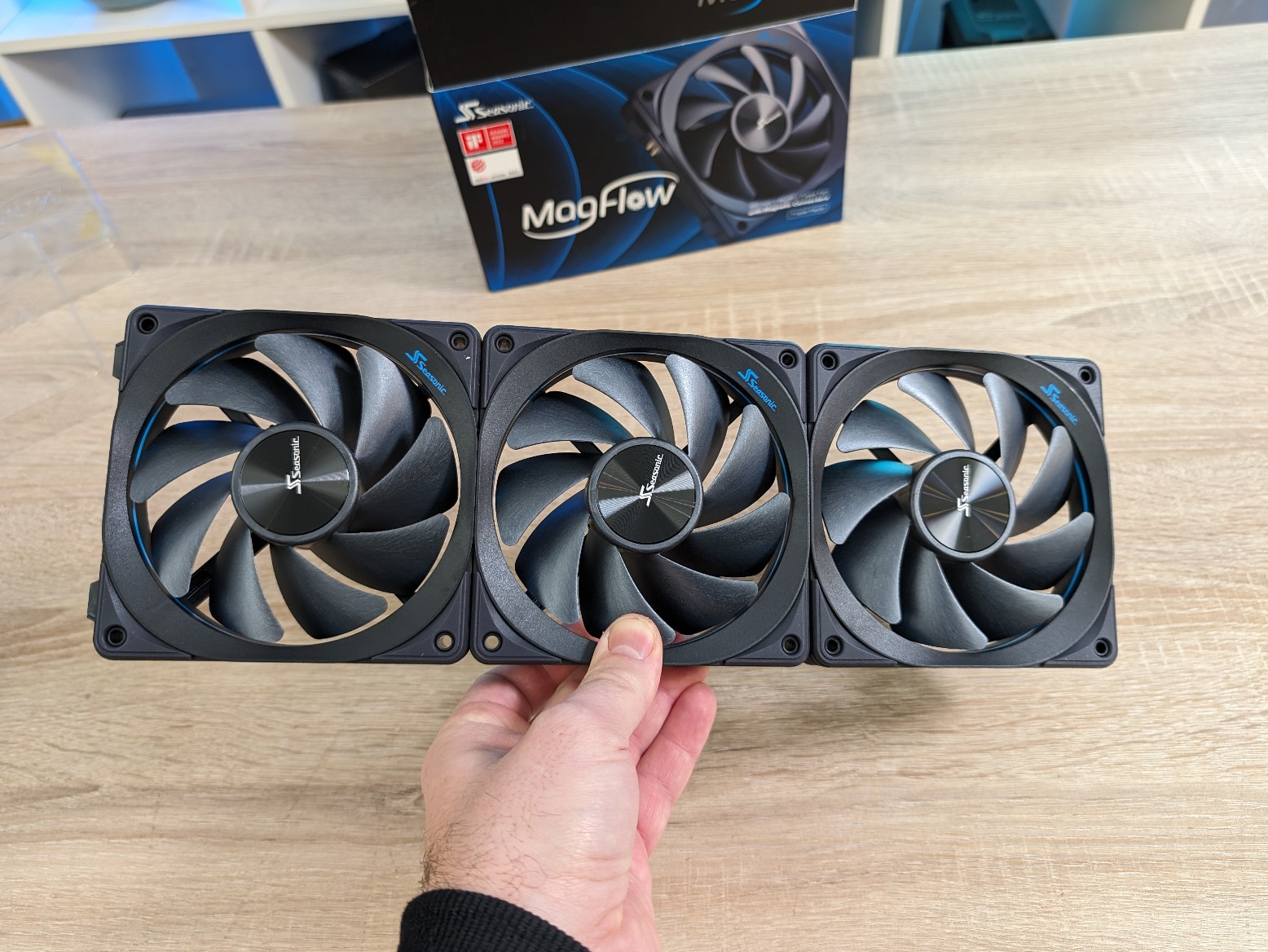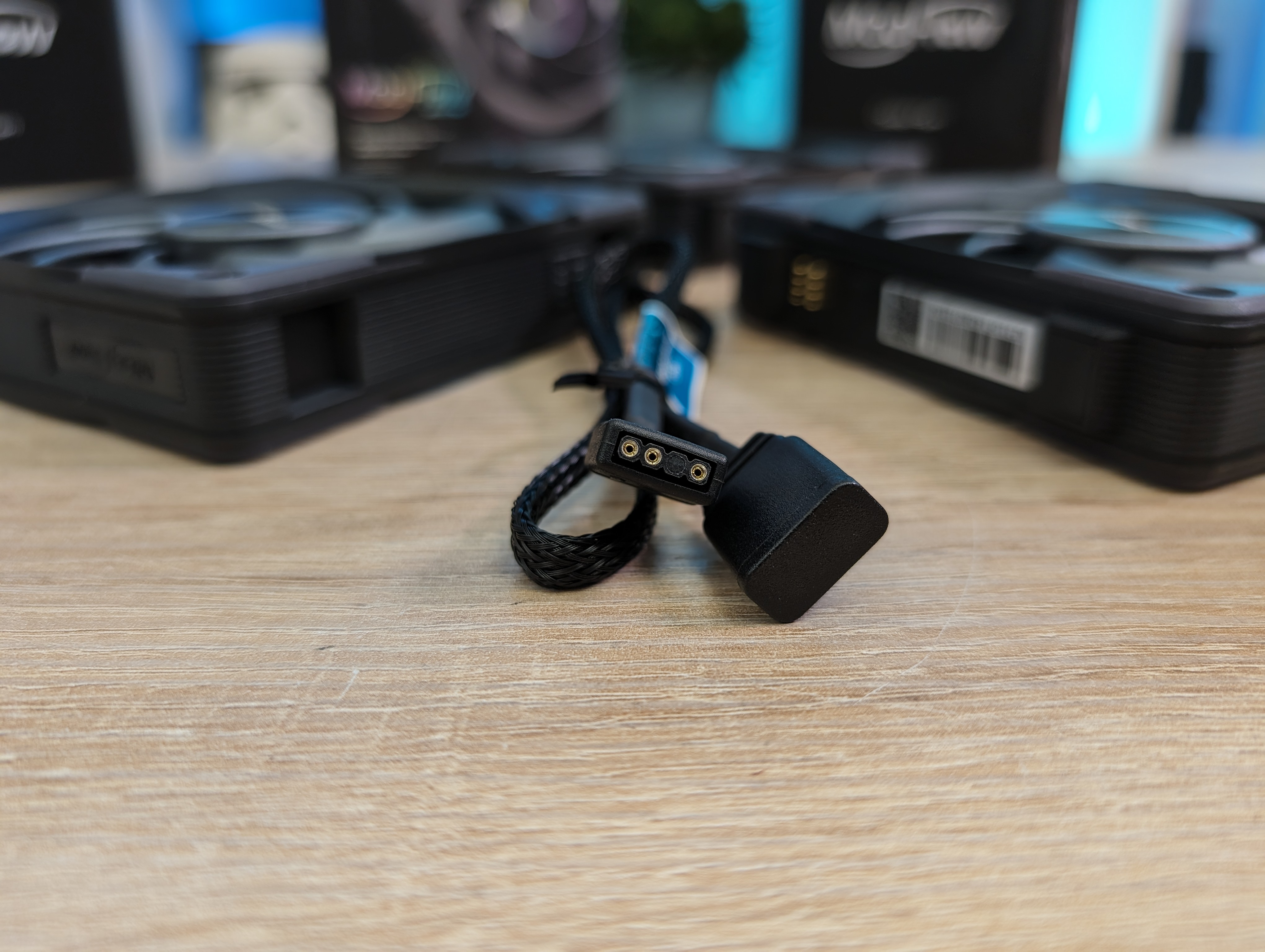Seasonic Magflow

Central features
- Daisy Chain Design
- Fluid Dynamic Bearings
- Simple and Neat Cable Management
The Magflow fans are available in a version with or without RGB lighting. The series is currently only available in 120mm versions.
A tour around the Seasonic Magflow
Although there are of course limits to how much you can vary the design of a fan that must fit into the 120mm standard, Seasonic has nevertheless made a good attempt.

The Magflow fans are made in a discreet and rather muted design with a combination of black and very dark blue materials. It can be difficult to see the difference between the regular and the RGB version, as the RGB elements are quite discreet.
On the RGB version there is an RGB ring in the center of the leaves and then another along the inside of the frame. Other than those, the RGB and non-RGB versions are pretty much the same.

Where the MagFlow fans differ the most, from the vast majority of fans on the market, is the way they are connected. Both in the way they are connected to each other and the way they are connected to your system.
If you look at the fans all by themselves, you will quickly discover that they have no cables connected. Instead, they have small pogo pin type plugs around the frame in a male and a female version. At the same time, magnets are installed in the frame in connection with the small connectors.

If you take two MagFlow fans, they can be connected easily and quickly and snap together magnetically. It's a surprisingly strong connection, and it takes quite a bit of pulling to get the fans apart again.
This means that it is super easy to assemble three fans for e.g. your 360mm radiator, whether it is a custom loop or an AIO.

To be able to connect your system, simply use one of the supplied cables. They connect to the fans via the same magnetic connectors and just click on. Since the fans are connected through each other, this means that only one cable is needed to drive the entire row.

The same applies to the RGB version of the MagFlow fans. Connecting multiple fans and connecting cables is exactly the same. The only difference is that both a PWM and an RGB cable go from the connectors, which must be connected.
The Daisy Chain method, however, ensures that both the PWM and RGB signal are passed on from one fan to the next.

If you need to have some distance between the fans, it is still possible to use the daisy chain method. For that purpose, Seasonic has made sure that there is a cable with it that can send the signal on.
That way, you can connect several sets through your system, without having to use dedicated PWM connectors on your motherboard. This makes it both easier to connect the fans, but also to control them afterwards, as they all run synchronously.

The MagFlow RGB fans naturally also have the ARGB connector that must be connected. It's really nice to see that Seasonic has chosen to use standard ARGB connectors and not insisted on inventing their own system, as you see with many others.
This means that they can be connected to virtually all modern motherboards and thus draw the ARGB signal from there. It also means that you can use the fans here, with virtually all kinds of RGB software on the market. It's great to have so much freedom for things.

If you prefer not to have to install more software, it is also possible to control the light locally via the small hub box that comes with the fans.
Here you can connect other ARGB devices and control them together via one device. Via the buttons on the small box, you can switch between a multitude of colors and patterns on your connected devices.
The biggest disadvantage here is of course that the little box typically ends up sitting hidden inside your system. This means that it is not easy to change the light or pattern without having to open up the cabinet.

However, SeaSonic has given us an opportunity to make it easier. If you can do without your reset button on the cabinet, you can choose to connect it to the small control box. If you do that, you can change the RGB light via your reset button. It's a neat little addition.

Price
I can currently find the Seasonic MagFlow fans in the triple pack version that we have had for testing with a price of just over 112$. This means that they are on the expensive end.
I have not been able to find a current price for MagFlow RGB
Conclusion
Seasonic has made a set of incredibly delicious fans with the MagFlow series. Materials and build quality are top notch, and there is no doubt that you are dealing with a set of solid fans.
Seasonic also provides a three-year warranty on the fans, so they themselves believe in their product.

In terms of connection and connectivity, it couldn't be easier. It all clicks together easily and quickly, and it's great to be able to connect a whole row of them without having to run cables for each individual fan.
However, you are also allowed to pay for the build quality and convenience, because the MagFlow series is on the expensive end. Compared to other high end fans, such as the Silent Wings 4 from BeQuiet, they match the price very well. All despite the fact that the MagFlow series have their advantages with easier connection and connection.

If you are looking for high-end fans and would like to enjoy easy connection and less cable clutter, the Seasonic MagFLow or MagFlow RGB may be the way forward.
We land with a final score of 8 for a beautiful set of fans that are not the quietest on the market. However, they are some of the easiest to connect and connect.
Advantage
- Good materials and build quality
- Super easy to connect
- Beautiful design
Disadvantages
- Noisier than other fans in this price range
- A little on the expensive side
Latest air cooling
-
24 Junair cooling
-
11 Marair cooling
be quiet! Pure Rock Pro 3
-
11 Febair cooling
be quiet! Silent Loop 3 360
-
19 Novair cooling
Night NF-A14x25 G2
-
18 Novair cooling
Tryx Panorama 240
-
08 Novair cooling
Noctua NH-D15 G2 LBC
-
07 Novair cooling
Arctic Liquid Freezer III 420
-
14 Octair cooling
Noctua confirms LGA1851 support
Most read air cooling
Latest air cooling
-
24 Junair cooling
Noctua ready with NF-A12x25 G2
-
11 Marair cooling
be quiet! Pure Rock Pro 3
-
11 Febair cooling
be quiet! Silent Loop 3 360
-
19 Novair cooling
Night NF-A14x25 G2
-
18 Novair cooling
Tryx Panorama 240
-
08 Novair cooling
Noctua NH-D15 G2 LBC
-
07 Novair cooling
Arctic Liquid Freezer III 420
-
14 Octair cooling
Noctua confirms LGA1851 support






